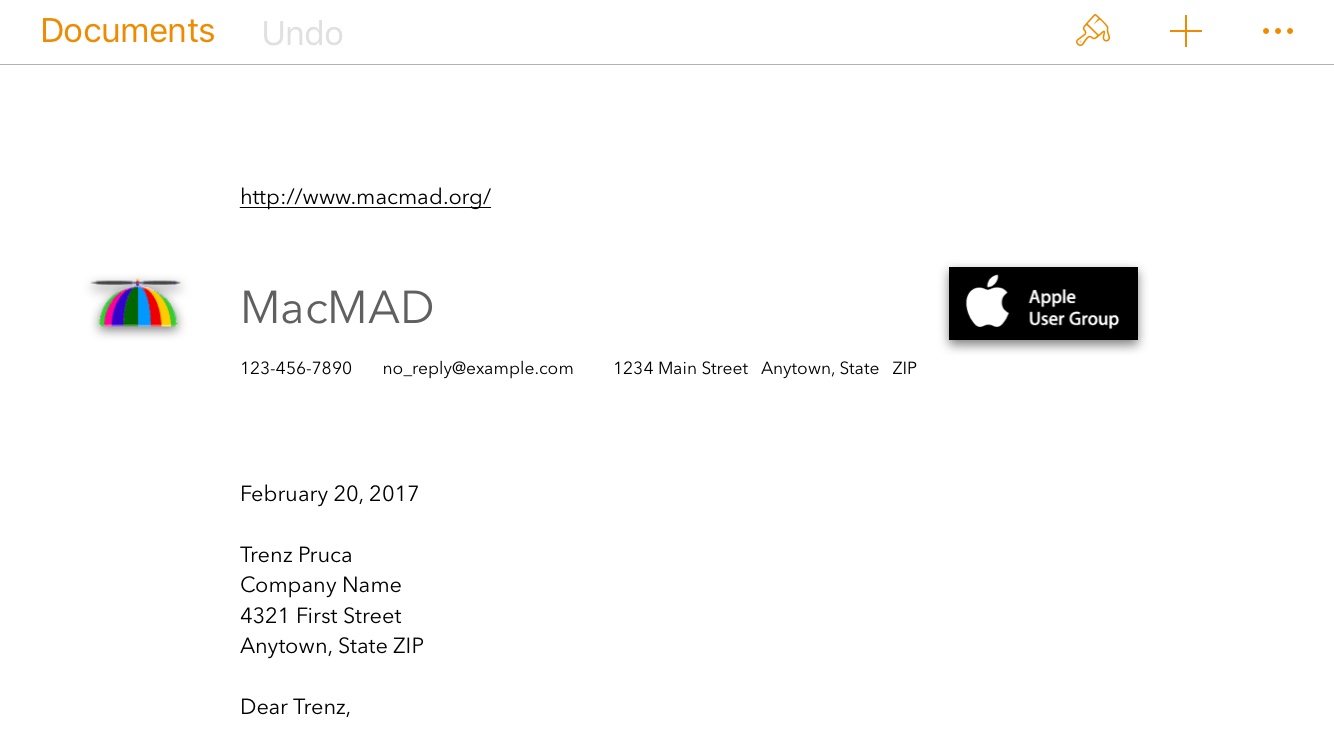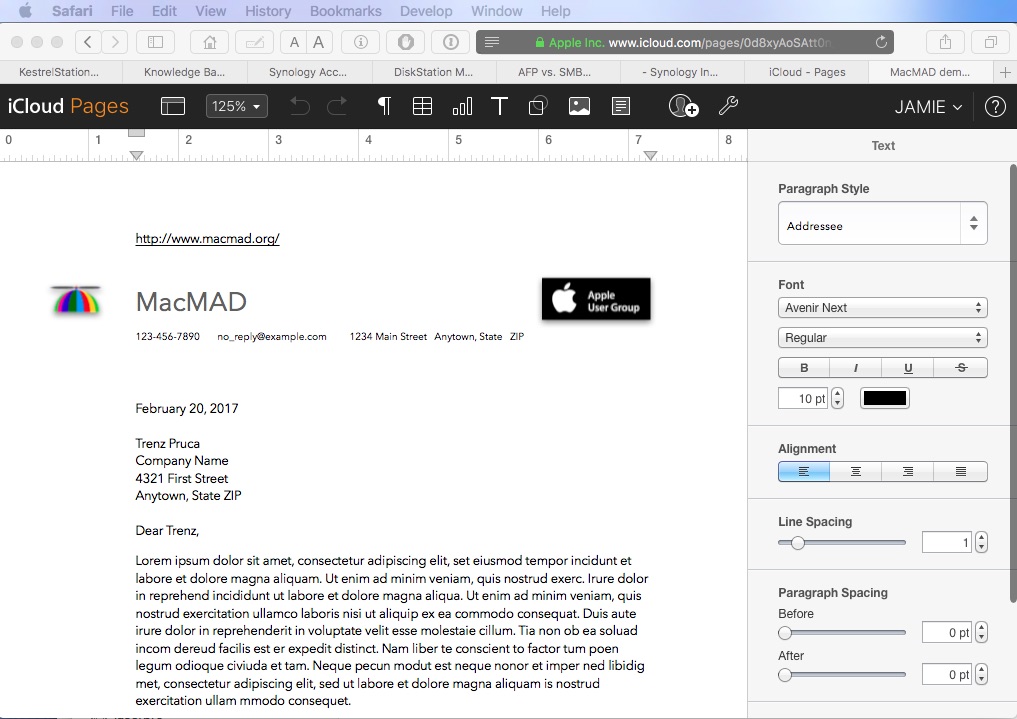Last night’s October 2017 MacMAD meeting covered the changes in iOS 11 and High Sierra. �Here are the slides on the High Sierra changes.
iOS 11.0.3 Fixes Problem with 3rd Party Replacement Screens
Apple released iOS 11.0.3 on Wednesday, October 11, 2017. The description of the release is as follows:
iOS 11.0.3 includes bug fixes for your iPhone or iPad. This update:
- Fixes an issue where audio and haptic feedback would not work on some iPhone 7 and 7 Plus devices
- Addresses an issue where touch input was unresponsive on some iPhone 6s displays because they were not serviced with genuine Apple parts
It so happens that I repaired my iPhone 6s screen recently with an apparently reputable, but non-Apple replacement screen.

Since the repair, I had noticed a few times when the touch screen became completely unresponsive. This was disconcerting at first, because an iPhone that doesn’t respond to any tap, touch, drag, etc. is pretty much a useless brick. However I found that just waiting about 1 minute or so with the screen off would bring it back to life. Since it didn’t happen but a few times, and since I knew a workaround, I didn’t complain to anybody.
Apparently, this was happening to enough people to reach the ears of Apple.
I want to give Apple a big thank you for putting in a software fix to work around a hardware problem that was not their fault. They could have done nothing. Some companies have gone so far as to deliberately disable unauthorized 3rd party hardware. Not Apple. Apple stuck by their customers, and this customer intends to stick by Apple.
Apple customers who used 3rd party replacement screens escaped with only a stern talking-to:
Note: Non-genuine replacement displays may have compromised visual quality and may fail to work correctly. Apple-certified screen repairs are performed by trusted experts who use genuine Apple parts.
While we’re on the subject of screen repair. Although I did successfully repair my own iPhone screen, I can’t really recommend doing it yourself. The process involved a jeweler’s magnifier, a guitar pick, a suction cup and six or eight nearly microscopic screws. I came extremely close to letting the magic smoke out of my iPhone. (Smoke must be what makes it work, because if the smoke ever comes out, it doesn’t work any more!)
I got away for about $50, but the folks who install a genuine Apple screen for, say, $150 are earning their money.
Meeting Topic: iTunes 12.7 September 2017
Our MacMAD meeting topic this month is iTunes. There are some interesting changes in the latest version. In particular, Apple has removed the purchase and management of iOS Apps from iTunes. This is a good step in the right direction to make iTunes less complicated and more focused.
Here is tonight’s Keynote presentation.
iPhone and iPad and the Elderly
In the process of helping older people with their iPhones and iPads, I have noticed certain problems common to many older users and solutions for some of those problems.
Unintended Actions
The first type of problem is unintended actions. This is when someone intends to do one thing, but accidentally does another. This can be as simple as typing the wrong character, but often includes major things like accidentally opening another app or pressing delete instead of save. I often see accidental swipes. The user intends to press a button or icon, but, perhaps due to poor motor control, instead swipes. Depending on the context, and where a swipe occurs, surprising things happen: the search window pops up, an email is deleted, etc.
One person asked me what the control center was and why it keeps popping up from the bottom of the screen. This was happening when she accidentally swiped up from the bottom of the screen invoking the control center.
You can make this less likely by turning off the control center from within apps. It can still appear on the home screen, but won’t pop up within any app. This setting is in Settings:Control Center:Access Within Apps.
I turned that off on my own phone and realized that I had probably been invoking Control Center more often by mistake than on purpose.
Touch Accommodations
Another very useful setting is in Settings:General:Accessibility:Touch Accommodations. If you turn on Touch Accommodations, the whole touch screen interface becomes less sensitive, and requires more deliberate actions. Buttons and other controls won’t activate until you press them for at least 1/10 of a second. That doesn’t sound like very long, but it makes a huge difference. Many accidental swipes and clicks will be eliminated.
Once enabled, you can adjust the delays. The default durations are probably okay for most people. If the user has severe tremors, then these settings can be increased. It might take a little bit of time to get used to this mode, but it can be worth it.
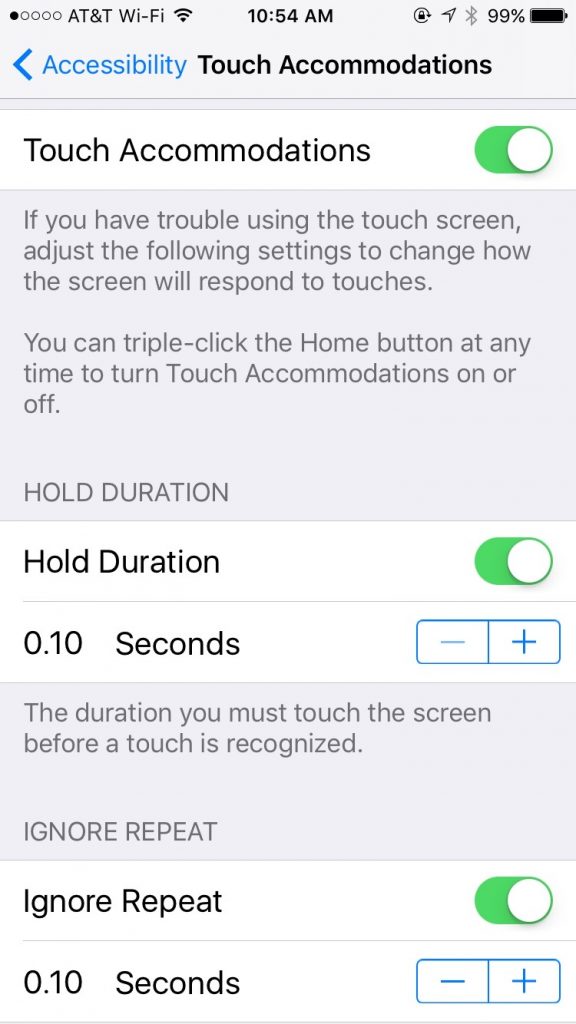
Overlooked Controls
The second category of problem is the “Oh, I didn’t know you could push that.” problem. iOS conceals many options behind innocuous looking symbols or words which are actually buttons that you can click, leading to useful functions. Often, people don’t notice those, or don’t realize that they are buttons.
There is a setting, General:Accessibility:Button Shapes, which outlines text buttons with a grey shape, making them look more like buttons. For example, notice how the word General has a gray background in the screen shot below.
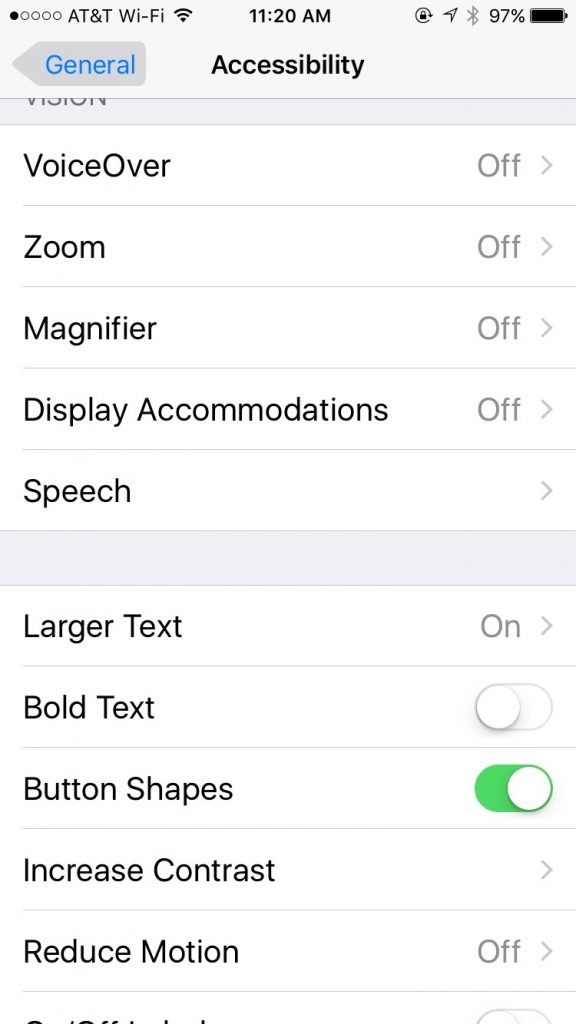
Try these settings for yourself or for your older friends and relatives. They could lead to a calmer, less frustrating experience with the iPhone or iPad.
Stellar Phoenix Mac Data Recovery
This is a guest post from Dennis Crowley
I have been given the opportunity to review Stellar Phoenix Mac Data Recovery Software. The Stellar Data Recovery Home page claims the software will perform safe and accurate recovery of lost documents, photos, music files, or videos that have been accidentally or intentionally deleted from Mac computer. While I did not review all the claims made by Stellar Data Recovery I did test the ability to recover deleted files.
I deleted some photo, Word, music and PDF files from my iMac and three days later tried to recover them. I was skeptical, so prior to deleting the files I copied them to a flash drive to insure they would not be lost. I ran the software, selected the appropriate drive and to my surprise all the deleted files were recovered and retained the original names.
The software comes with an online User Manual. Although the software is slightly expensive the cost is offset by the ability to recover priceless photos or documents.
Stellar Phoenix Mac Data Recovery Software is a good product and does what it claims.
Two-Factor Authentication for Apple ID
Two-Factor Authentication and One-Time Passwords
MacMAD Meeting Topic for June 20, 2017
Your Apple ID is your single set of credentials for everything from Apple, including:
- iCloud files, calendars, contacts, etc.
- Photos
- purchases on the iTunes store
- buying hardware on the Apple Store
This is pretty important stuff, right? You don’t want your credentials to fall into the wrong hands!� Until recently, those credentials consisted of only your username and password, which seldom change. If a bad guy got hold of those, he’d have complete access to your Apple identity.
To help prevent that, Apple set up Two-Factor Authentication (2FA).� With 2FA, in addition to username and password, you must also give a verification code. Verification codes are sent to your phone or other trusted device. The verification code is different each time you log on.
Two-Factor Authentication is optional for users. However, you may now be forced to use it if you use certain apps — those which access your iCloud account.
Some apps require access to your files in iCloud, and therefore need your iCloud credentials to do so. This is fine, but you don’t want them to have the keys to your entire kingdom, do you? You don’t want a calendar app to order a new Macintosh, or delete your photos.
To control such apps, Apple now requires them to access iCloud using a One-Time password. This allows them to bypass 2FA, but using a special password which is only useable by that app for limited purposes. Once you give a one-time password to an app, and it uses it, it can never be used again for any other purpose.
You do not need to store or remember one-time passwords. If for some reason you need to re-authorize an app, you can simply generate a new one-time password for it.� Dennis explains how to do all this in these slides from this month’s meeting:
Apple Two-Factor Authentication 2017
Apple Pay at Disney and Beyond
If you go to Walt Disney World this summer,� I think you’ll find that all the credit card terminals there accept Apple Pay. At Epcot, I paid for a tee shirt with Apple Pay, and even for a coke from a refreshment stand. That saved me from ending up with a bunch of small change.
The San Angel Inn Restaurante in the Mexico pavillion at World Showcase also accepted Apple� Pay. I had already paid with a physical credit card when I saw the contactless payment logo. The waiter brought the portable terminal to the table European-style. He confirmed that they can accept Apple Pay. “It’s faster,� too.”
When you are in an unfamiliar store, you can get a pretty good idea of whether to try Apple Pay based on the credit card reader you see. If you see a Verifone brand credit card reader, especially if it looks like this, it is very likely to accept Apple Pay. Recognize it by the slight hood over the keypad. Some merchants have these machines and the clerks don’t even know that Apple Pay will work until it happens.
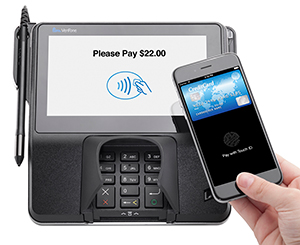
On the other hand, if you see Ingenico equipment, which is very common, Apple Pay will definitely not work at that terminal.
Happy shopping!
The Best Shared Shopping List App You Already Have!
I set out recently to find a shared iOS shopping list App to replace my family’s paper grocery shopping list. I had some pretty simple requirements:
- Easy-to-use sharing between family members using different iCloud accounts
- Ability to review the list in the store and mark items off
- Ability to review and revive completed items (We’ve got milk this time, but we’ll need it again soon)
I spent some time in the App store looking at reviews and didn’t see anything I wanted to buy. Some otherwise useful apps had a bad reputation for crashing. Others were just too complex. Some needed a subscription and a sign-on for sharing to work. It’s just creepy that the vendor would be watching everything on your shopping list.
Eventually I found it. An app that was already on my phone that met all my requirements and didn’t need any additional sign-ups, plus you can use Siri to add items to the list by voice.
The app is:� Reminders — the humble Apple Reminders app that comes with iOS.
Here’s an overview from iMore on how to set Reminders up for sharing.
A couple of tips:
- You can have more than one list.
- Remember the name of your lists: “Shopping List” and “Grocery List” aren’t the same to Siri.
- When you invite someone to share your list, they may have to sign on to iCloud on the web the first time to accept the invitation, but after that it can be strictly iPhone-to-iPhone.
- Everyone invited has equal ability to add, delete and edit items on the list.
- Tap at the bottom of the reminders App screen to see your other reminder lists.
Enjoy!
Meeting Topic: Apple’s Numbers Spreadsheet App
March 21, 2017 Meeting Topic Overview: Numbers
by Jamie Cox
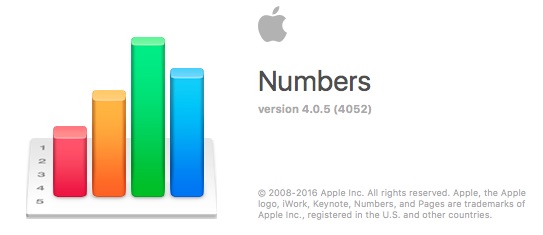
There are three ways to run Numbers:
- On the Macintosh
- On iOS (iPhone or iPad)
- From a Web Browser on iCloud
�How to Get�Numbers
Numbers�probably came with your Mac or iOS device, or get�Numbers�via the Mac App Store�($19.99),�or get�Numbers��via the iTunes App Store�($9.99).

Competition / Alternatives to �Numbers
- Microsoft Excel(Office)�� For giant documents and giant companies (Now with iOS version)
- Open Office�� Free and Open Source Office suite
- NeoOffice���Commercialized version of Open Office customized for the Mac
- GoogleDocs�� Cloud-based, free
Controversy Since iWork ’09
When the new version of Numbers�for the Mac came out some features were dropped. Most of them have not been added back in. Reviews of the apps have been definitely mixed. Numbers only gets a 3-star rating on the App store (both versions).

Two-and-a-half to three stars�is a pretty terrible rating, especially for an Apple app. As you can see, the ratings are very mixed with most reviewers giving either one star or�five-star ratings. The ratings for the iOS version are very similar.
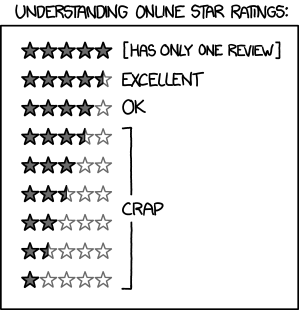
The one-star reviews are mostly from people upset�about advanced features removed from the previous version. The five-star reviews tend to be�from people who have come to the application fresh, with no special expectations.
Numbers includes hundreds of distinct features. The chart below highlights just a few�of my�favorite features as compared with Microsoft Excel.
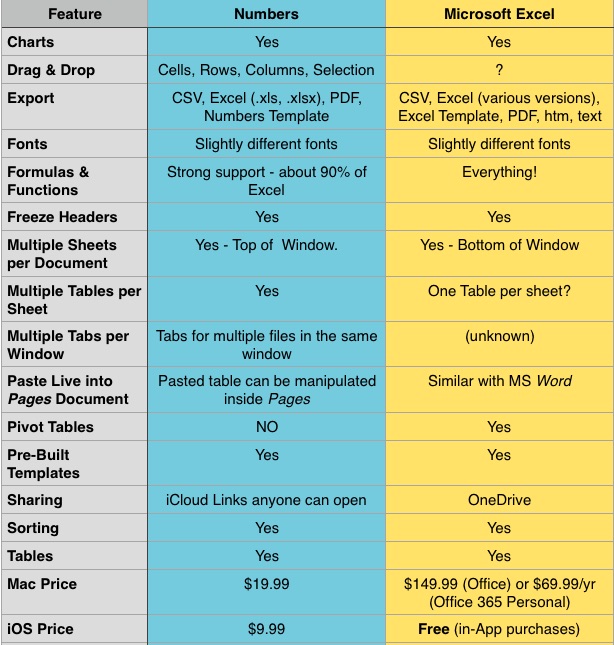
Documents, Sheets and Tables
Numbers documents can have multiple sheets. Each sheet can have multiple tables. When you create a new Numbers document, it has one sheet with one table on that sheet.
If you have used Excel, having multiple sheets should be familiar. The main difference is that the sheets appear at the top of the window instead of at the bottom.
The concept of having multiple tables on a single sheet may be new to users of older spreadsheet programs. It is a very nice feature, which allows you to separate groups of data or �formulas which are of different types instead of lumping them all into the same grid of rows and columns. You can arrange the tables on the page however you like.
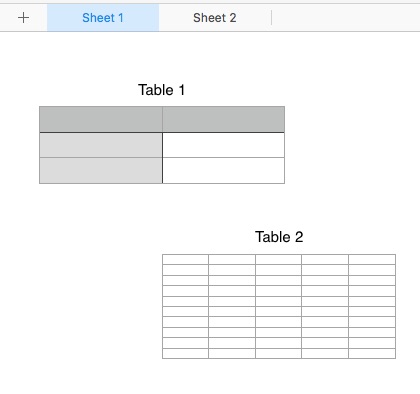
Formatting Controls
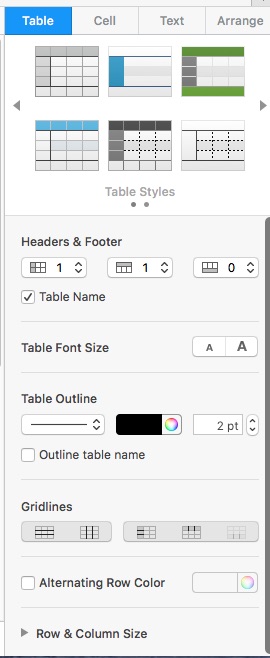
Numbers uses a consistent set of formatting controls very similar to those in the Pages word �processor we discussed last month. These are presented �in a pane on the right hand side of the window. These controls look simple, but all together, they have a lot of power. In addition to the pre-defined Table and Text styles, you can create and save your own preferred styles.
Formula Editing
Type an equals sign to enter formula editing mode for a cell. Color coding appears showing the source cells used in your formula. This �makes it easier to understand if your formula is correct or to see the source �of errors.
When you copy or fill a formula into additional cells, Numbers automatically adjusts cell references relative to the current cell. If you want to override that to select an absolute row, �absolute �column, or absolute cell, you can use the Preserve Row/Preserve Column options.
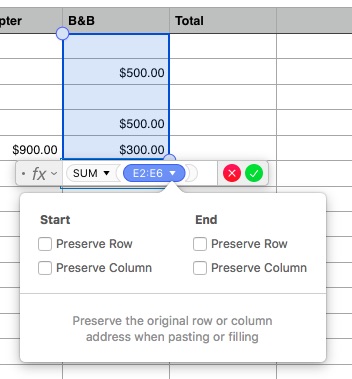
Importing Files From Excel
A common task in Numbers would be to open an Excel document created�by someone else. This can work fairly well, but is not completely painless.
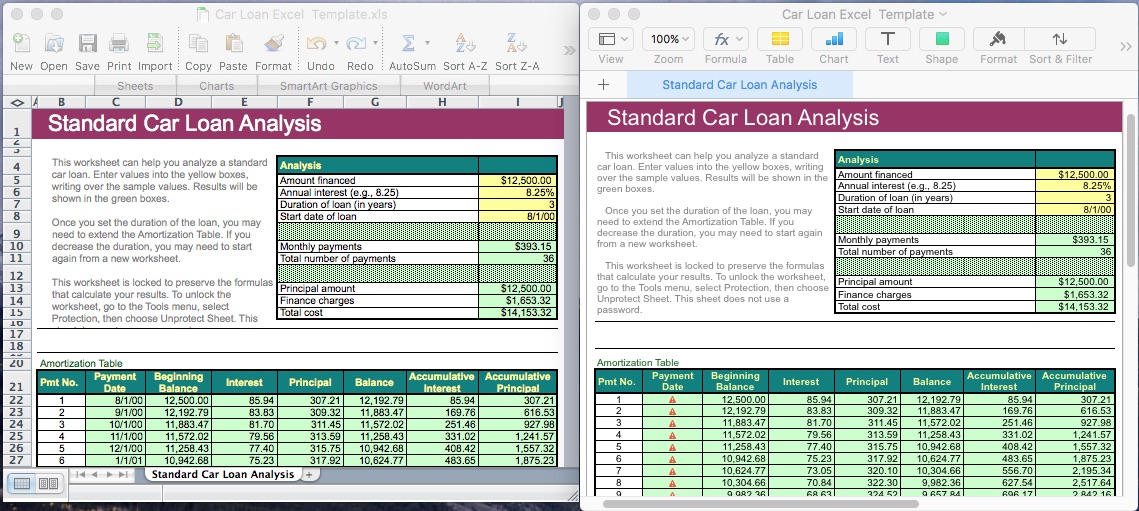
This imported okay, and the amortization calculations agreed, but the date formulas were not imported correctly and would have to be re-done in numbers.
Large Files
One of our members asked how Numbers was at handling large files imported from Excel. To test this I created a large spreadsheet in Excel with 40,000 rows and about 14 columns. The file size in Excel was 3.7 Megabytes. Numbers opened it without complaint, but it took about 30 seconds. When saved as a native Numbers document, its size increased to 6.3 Mbytes, but the native document opened in Numbers in about five seconds.
Although I didn’t get any warnings in Numbers, I did get one “Not enough memory” message in Excel while cutting, pasting and filling to create the document. Excel handled it gracefully without crashing.
iOS Numbers App
The Numbers app on iOS is deliberately very similar to the version for �Macintosh.
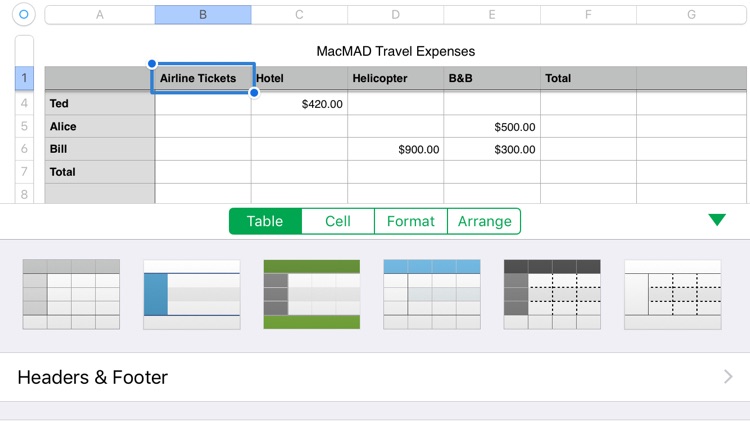
FYI, Excel also has an iOS app which is free in the App store. It looks like this:
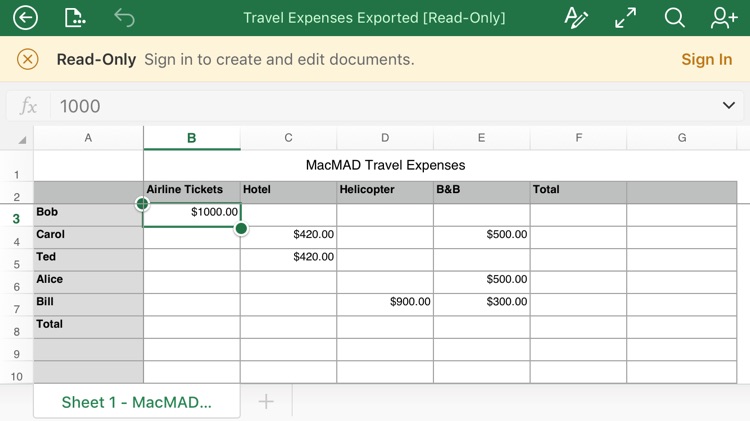
The Excel app is apparently read-only until you register for and log in to a Microsoft Office 365�account.
�Conclusion
If you want a spreadsheet program to perform the usual tasks of calculation, sorting and organizing, and you don’t have much prior experience with spreadsheets, �you will find Numbers a very useful application. It’s especially easy to learn because of�consistent controls across Mac and iOS versions and consistency with Pages and Keynote.
If you know what a pivot table is, or have a lot of spreadsheets already in Excel format, you may be dissatisfied with the limitations of Numbers.
Meeting Topic: Apple’s Pages Word Processor
Feb 21, 2017 Meeting Topic Overview: Pages
by Jamie Cox
“Expect a lot from software and you’ll usually get �it.” � � � � � � � � �– Eric Newman, MacMAD President emeritus
In Feb 2017, the current version of Pages for Mac is 6.0.5. For iOS it is version 3.0.5.�
There are three ways to run Pages:
- On the Macintosh
- On an iPhone or iPad
- From a Web Browser on iCloud
�Pages Running on the Mac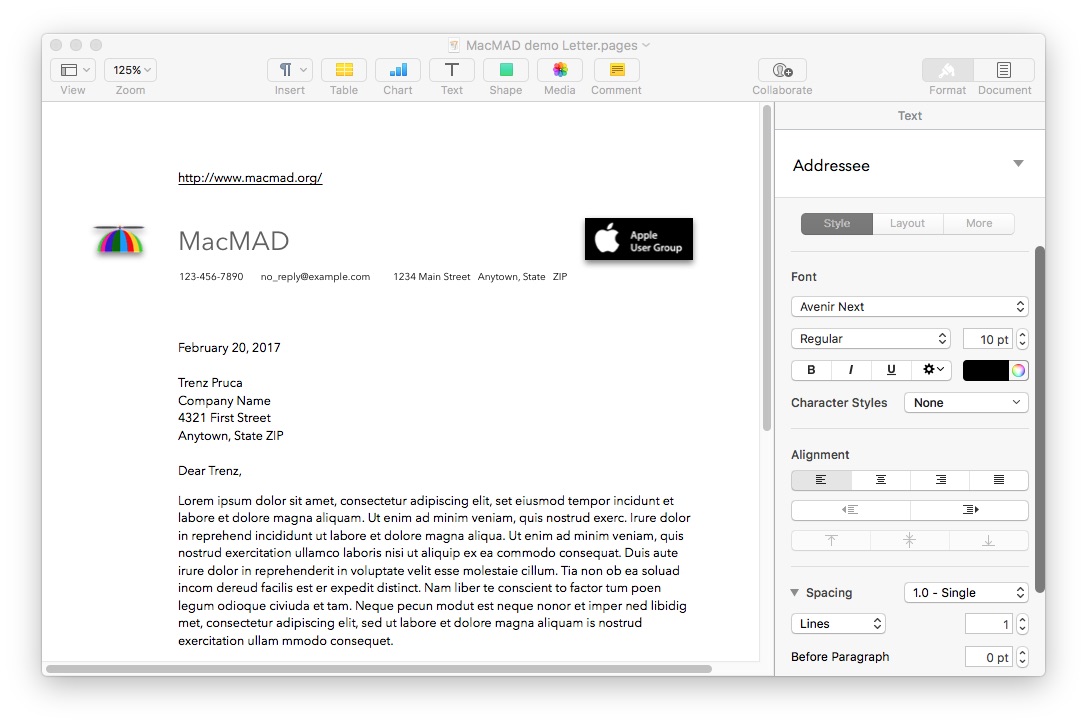
Pages Running on the iPhone
Pages �Running in a Browser from iCloud.com
How to Get Pages
Pages probably came with your Mac or iOS device, or get�Pages via the Mac App Store�($19.99),�or get�Pages via the iTunes App Store�($9.99).

Competition / Alternatives to �Pages
- TextEdit – came with your Mac; Open Source; For simple tasks,�it does more than you think
- Microsoft Word (Office) – For giant documents and giant companies (Now with iOS version)
- Open Office – Free and Open Source Office suite
- NeoOffice -�Commercialized version of Open Office customized for the Mac
- GoogleDocs – Cloud-based, free
What Pages Does
Although Pages has a deceptively clean and simple design, it does a lot of things you might have expected�to need separate applications�for. Pages includes these functions:
- Word Processing (obviously)
- Page Layout
- Spreadsheet
- Charting
- Photo Editing
- Publishing
- Collaboration Software
Integration with iCloud
Work on your document from all your devices.
Pages Has Two Document Types
All Pages documents are either:
- Word Processing Documents, or
- Page Layout Documents (have no body)
Word Processing documents have body text which is a continuous flow of text within the document. It may flow around images, tables, etc.
Page Layout documents have no body. All text in a page layout document exists as part of �something else: a text box, a shape, or a table.
Consistent Text Operations
Text can exist in:
- The document body,
- Text boxes
- Shapes,
- Tables,
- The header and footer
All are treated consistently�as far as styles and formatting.
Shapes and Images
- Wrap
- Align
- Resize
- Rotate
- Shapes can have text with the �usual attributes
- Images can not have text
- Shapes have adjustable opacity
- Images have opacity and Instant Alpha
- Opacity is the opposite of transparency
- Alpha is�just�selective transparency – pixel-by-pixel
Import and Export
Import Microsoft Word Format
Export Your Document As:
- ePub – for eBook readers like Kindle and iBook
- Microsoft Word
- Pages ’09 – For users of older versions of Pages
Learn More
Pages 101 Tutorial Video with David A Cox�(YouTube) (no relation)

